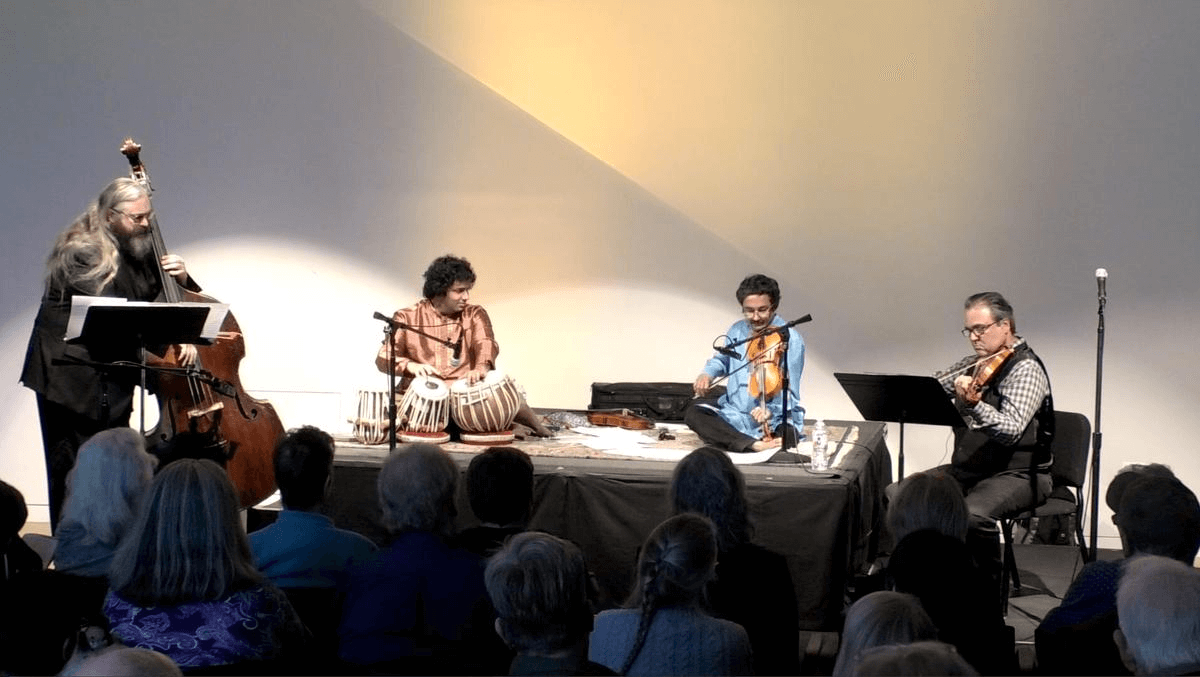Musicians use a math formula to mix music
(by Libby Hanssen for KCUR)

Using math to interpret music is not new — Pythagoras supposedly discovered the connection between ratios and consonant sounds back in the 6th Century BC.
Carrying on that millennia-old practice is University of Kansas professor of mathematics Purnaprajna Bangere, who uses algebraic geometry to integrate Indian classical music with Western styles like blues and jazz. He has just released a new album.
"Just like the common DNA among all humans is 95%, there are structural similarities and rhythmic similarities among different genres," he says.
Indian classical music includes hundreds of raga: set note patterns with complex microtones, composed in a sort of vertical structure. Western music, meanwhile, moves horizontally on pure tones through chord changes.
Bangere recognized there were ways to connect these systems, using the blues and its inherent microtones, i.e., blue notes, as a bridge. The result is a style distinctly rooted in raga, which moves and shifts through keys, taking dynamic risks reflecting the heritage of jazz.
"It is like no man's land music — actually, a new land," says Bangere.
He calls his new system "metaraga," which is also the name of the album.
Joining him on this expedition are San Francisco-based violinist David Balakrishnan (founder of the Grammy Award-winning Turtle Island String Quartet), Kansas City bassist Jeff Harschbarger, and Boston-based tabla virtuoso Amit Kavthekar. They form the Purna Loka Ensemble. (In Sanskrit, "purna" means complete and "loka" means world.)
The Purna Loka Ensemble performs at the University of Kansas' Lied Center in October 2018. Credit Purna Loka Ensemble
Bangere created this musical place by using algebraic geometry concepts espoused by the 20th century mathematician Alexander Grothendieck to find similarities between different styles of music.
Bangere has been thinking about this all his life.
"The seeds for this globalization of music, as I call it, in my consciousness, happened 40 years ago, even 45 years ago, when I was a kid," he says.
Bangere grew up in southern India, in a city called Mysore. He rigorously studied the Parur style of Carnatic classical music, practicing violin five or six hours a day. He also listened to Western classical music. But when it came time to choose a career, he followed family tradition and studied mathematics.
"My father is a mathematician, a teacher of mathematics, so mathematics was always in the air," he says. "I picked up mathematics by osmosis and music by intent."
He came to the United States in 1991 to study at Brandeis University in Boston. That was when he first heard blues and jazz.
"It moved the heck out of me because I was missing home at the same time," Bangere says. "It was a homesickness that was traumatic. Somehow the blues get to you."
Bangere started venturing outside of the musical traditions he'd grown up with. Even as he continued to perform Indian classical violin, he kept exploring elements of the other music he loved: Aretha Franklin, Sister Rosetta Tharpe, John Coltrane.
The musicians on "Metaraga" are all multi-genre instrumentalists and have played with Bangere for years. He met fellow violinist Balakrishnan in 2008.
"He wants to go towards East, I want to move towards West, so naturally we meet and we strike a friendship," he says. Bangere and Balakrishnan are co-composers on four of the album’s eight tracks.
Though he uses formulas to integrate styles, the melodic ideas and inspiration come from everywhere and anywhere. "Syzygy," the album's first song, demonstrates how the ensemble connects different genres. The word, in Greek, means "yoking" (Bangere's graduate thesis was also based on the concept of syzygy).
The album is centered on a three-movement work, "Triality," based on the concept of the Hindu trinity: Brahma, Vishnu and Shiva. The melody for the second movement was inspired by Bangere's son jumping on the bed; the third is a mediation on the tragedy of the 2018 shooting in Parkland, Florida.
"In some sense you have creation in the first, and then you preserve in the second movement. And then the third is destruction, actually," he says.
The album also includes an arrangement of Coltrane's "Alabama." Clarinetist Robert Walzel joins the ensemble on this track.
"First of all, John Coltrane is a genius. He moves me deeply. He also is a person who doesn't really let a genre overpower his consciousness," Bangere says.
"He was deeply influenced by Indian classical music," Bangere adds. "I felt somehow that it preserves the spirit of Coltrane and yet it somehow extends."
Bangere says this new music is like a traveler going through many different musical lands.
"He's going back and forth without any concern. No visa problems, no boundaries. It's like how humans ought to be living.”
KCUR contributor Libby Hanssen writes the culture blog Proust Eats A Sandwich. Follow her on Twitter, @libbyhanssen.




